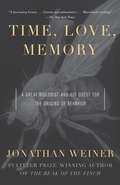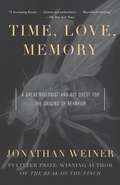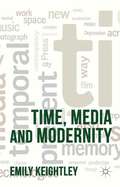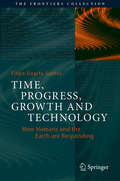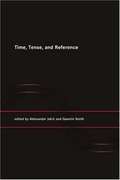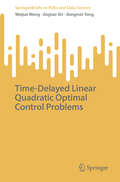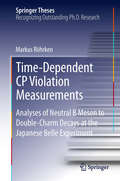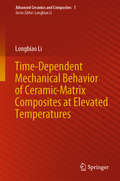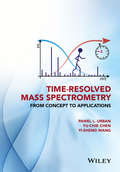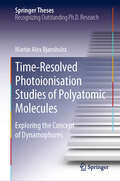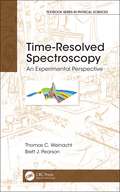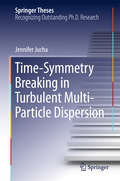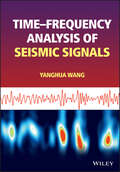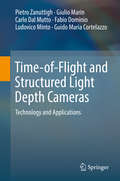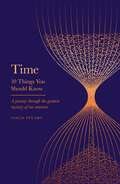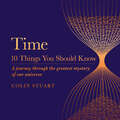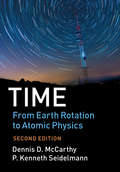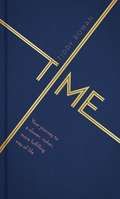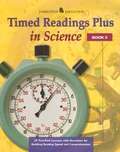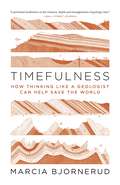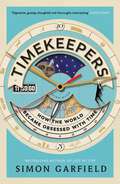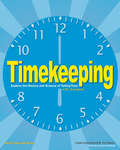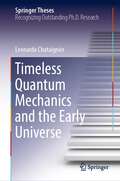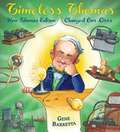- Table View
- List View
Time, Love , Memory
by Jonathan Weiner"A fascinating history--. Literate and authoritative--.Marvelously exciting." --The New York Times Book ReviewJonathan Weiner, winner of the Pulitzer Prize for The Beak of the Finch, brings his brilliant reporting skills to the story of Seymour Benzer, the Brooklyn-born maverick scientist whose study of genetics and experiments with fruit fly genes has helped revolutionize or knowledge of the connections between DNA and behavior both animal and human.How much of our fate is decided before we are born? Which of our characteristics is inscribed in our DNA? Weiner brings us into Benzer's Fly Rooms at the California Institute of Technology, where Benzer, and his asssociates are in the process of finding answers, often astonishing ones, to these questions. Part biography, part thrilling scientific detective story, Time, Love, Memory forcefully demonstrates how Benzer's studies are changing our world view--and even our lives.
Time, Love, Memory: A Great Biologist and His Quest for the Origins of Behavior
by Jonathan WeinerJonathan Weiner brings his skills to the story of Benzer, the Brooklyn-born maverick scientist whose study of genetics and experiments with fruit fly genes has helped revolutionize the connections between DNA and behavior both animal and human.
Time, Media and Modernity
by Emily KeightleyA wide ranging, interdisciplinary exploration of media time and mediated temporalities. The chapters explore the diverse ways in which time is articulated by media technologies, the way time is constructed, represented and communicated in cultural texts, and how it is experienced in different social contexts and environments.
Time, Progress, Growth and Technology: How Humans and the Earth are Responding (The Frontiers Collection)
by Filipe Duarte SantosThis book addresses the current challenges of sustainable development, including its social, economic and environmental components. The author argues that we need to develop a new concept of time based on inter-generational solidarity, which focuses both on the long- and the short term. The evolution of man's notions of time are analyzed from prehistory to modern times, showing how these concepts shape our worldviews, our ecological paradigms and our equilibrium with our planet. Practical approaches to dealing with the major medium- and long term sustainability challenges of the 21st century are presented and discussed. This is a thought provoking and timely book that addresses the main global socioeconomic and environmental challenges facing the current and future generations, using science-based analysis and perspectives. It presents an historical narrative of the advent of progress, economic growth and technology, and discusses the structural changes needed to co-create sustainable pathways. It provides hope for our future on Earth, mankind’s common home. António Guterres, Secretary-General of the United Nations This is an amazing, almost mind-boggling book. The author takes a look at the true whole, i.e., the development of the human enterprise since its very beginning. This enterprise is evidently a possibility under the boundary conditions of cosmological dynamics and natural evolution, but evidently also a highly improbable one. It is all but a miracle that the Earth system in its present form exists and happens to support a technical civilization. Will this civilization last long, will it transform itself into something even more exceptional, or will it perish in disgrace?Santos dares to address these grandest of all questions, equipped with a unique transdisciplinary wisdom drawing on physics, cybernetics, geology, biology, economics, anthropology, history, and philosophy. And he dares to dive into the deepest abysses of thinking, where categorial monsters like time and progress lurk. Thereby, he takes us on fascinating journey, during which we perceive and grasp things we have never seen and understood before. One of the best essays I have ever read. John Schellnhuber, founding director of the Potsdam Institute for Climate Impact Research (PIK) and former chair of the German Advisory Council on Global Change
Time, Tense, and Reference
by Aleksandar Jokic Quentin SmithAmong the many branches of philosophy, the philosophy of time and the philosophy of language are more intimately interconnected than most, yet their practitioners have long pursued independent paths. This book helps to bridge the gap between the two groups.
Time-Delayed Linear Quadratic Optimal Control Problems (SpringerBriefs on PDEs and Data Science)
by Jiongmin Yong Weijun Meng Jingtao ShiThis book characterizes the open-loop and closed-loop solvability for time-delayed linear quadratic optimal control problems. Different from the existing literature, in the current book, we present a theory of deterministic LQ problems with delays which has several new features: Our system is time-varying, with both the state equation and cost functional being allowed to include discrete and distributed delays, both in the state and the control. We take different approaches to discuss the unboundedness of the control operator. The open-loop solvability of the lifted problem is characterized by the solvability of a system of forward-backward integral evolution equations and the convexity condition of the cost functional. Surprisingly, the adjoint equations involve some coupled partial differential equations, which is significantly different from that in the literature, where, the adjoint equations are all some anticipated backward ordinary differential equations. The closed-loop solvability is characterized by the solvability of three equivalent integral operator-valued Riccati equations and two equivalent backward integral evolution equations which are much easier to handle than the differential operator-valued Riccati equations used in the literature to study similar problems. The closed-loop representation of open-loop optimal control is presented through three equivalent integral operator-valued Riccati equations.
Time-Dependent CP Violation Measurements
by Markus RöhrkenThis thesis describes a high-quality, high-precision method for the data analysis of an interesting elementary particle reaction. The data was collected at the Japanese B-meson factory KEKB with the Belle detector, one of the most successful large-scale experiments worldwide. CP violation is a subtle quantum effect that makes the world look different when simultaneously left and right and matter and antimatter are exchanged. This being a prerequisite for our own world to have developed from the big bang, there are only a few experimental indications of such effects, and their detection requires very intricate techniques. The discovery of CP violation in B meson decays garnered Kobayashi and Maskawa, who had predicted these findings as early as 1973, the 2008 Nobel prize in physics. This thesis describes in great detail what are by far the best measurements of branching ratios and CP violation parameters in two special reactions with two charm mesons in the final state. It presents an in-depth but accessible overview of the theory, phenomenology, experimental setup, data collection, Monte Carlo simulations, (blind) statistical data analysis, and systematic uncertainty studies.
Time-Dependent Mechanical Behavior of Ceramic-Matrix Composites at Elevated Temperatures (Advanced Ceramics and Composites #1)
by Longbiao LiThis book investigates the time-dependent behavior of fiber-reinforced ceramic-matrix composites (CMCs) at elevated temperatures. The author combines the time-dependent damage mechanisms of interface and fiber oxidation and fracture with the micromechanical approach to establish the relationships between the first matrix cracking stress, matrix multiple cracking evolution, tensile strength, tensile stress-strain curves and tensile fatigue of fiber-reinforced CMCs and time. Then, using damage models of energy balance, the fracture mechanics approach, critical matrix strain energy criterion, Global Load Sharing criterion, and hysteresis loops he determines the first matrix cracking stress, interface debonded length, matrix cracking density, fibers failure probability, tensile strength, tensile stress-strain curves and fatigue hysteresis loops. Lastly, he predicts the time-dependent mechanical behavior of different fiber-reinforced CMCs, i.e., C/SiC and SiC/SiC, using the developed approaches, in order to reduce the failure risk during the operation of aero engines. The book is intended for undergraduate and graduate students who are interested in the mechanical behavior of CMCs, researchers investigating the damage evolution of CMCs at elevated temperatures, and designers responsible for hot-section CMC components in aero engines.
Time-Resolved Mass Spectrometry
by Yi-Sheng Wang Yu-Chie Chen Pawel L. UrbanTime is an important factor in physical and natural sciences. It characterizes the progress of chemical and biochemical processes. Mass spectrometry provides the means to study molecular structures by detecting gas-phase ions with the unique mass-to-charge ratios. Time-resolved mass spectrometry (TRMS) allows one to differentiate between chemical states that can be observed sequentially at different time points. Real-time mass spectrometric monitoring enables recording data continuously with a specified temporal resolution. The TRMS approaches - introduced during the past few decades - have shown temporal resolutions ranging from hours down to microseconds and beyond.This text covers the key aspects of TRMS. It introduces ion sources, mass analyzers, and interfaces utilized in time-resolved measurements; discusses the influence of data acquisition and treatment; finally, it reviews most prominent applications of TRMS - in the studies of reaction kinetics and mechanism, physicochemical phenomena, protein structure dynamics, biocatalysis, and metabolic profiling.It will assist science and engineering students to gain a basic understanding of the TRMS concept, and to recognize its usefulness. In addition, it may benefit scientists who conduct molecular studies in the areas of chemistry, physics and biology.
Time-Resolved Photoionisation Studies of Polyatomic Molecules: Exploring the Concept of Dynamophores (Springer Theses)
by Martin Alex BjørnholstThis book explores how structure impacts the dynamics of organic molecules in an extensive and impressive range of femtosecond time-resolved experiments that are combined with state-of-the-art theoretical approaches. It explores an area of molecular dynamics that remains largely uncharted and provides an extraordinary overview, along with novel insights into the concept of the dynamophore – the functional group of ultrafast science. Divided into four parts, this book outlines both experimental and computational studies on the VUV photoinduced dynamics of four cyclic ketones and one linear ketone, the ring-opening and dissociative dynamics of cyclopropane, and the potential ultrafast intersystem crossing in three methylated benzene derivatives. Model systems for the disulfide bond and the peptide bond, both of which are related to the structure of proteins, are also investigated. This highly informative and carefully presented book offers a wealth of scientific insights for all scholars with an interest in molecular dynamics.
Time-Resolved Soft X-Ray Absorption Spectroscopy of Molecules in the Gas and Liquid Phases (Springer Theses)
by Cédric SchmidtThis work studies the relaxation dynamics of molecules in both the gas and liquid phases after strong field ionization, using transient absorption in the soft X-rays. In particular, the thesis presents the first realization of time-resolved X-ray absorption spectroscopy in the spectral water window with a laser-based HHG source. These remarkable experiments were not only performed for isolated molecules, but also in liquids, for which the spectral coverage of the K-edges of C, N, and O are of primary importance for investigating biological molecules. The technique relies on the generation of high-order harmonics to further probe the electronic structure of molecules. Using the atomic selectivity of high energies and the temporal coherence of laser technology, we demonstrate the observation of the first stages of chemical transformation of matter in the gas and liquid phases.
Time-Resolved Spectroscopy: An Experimental Perspective (Textbook Series in Physical Sciences)
by Thomas Weinacht Brett J. PearsonThis concise and carefully developed text offers a reader friendly guide to the basics of time-resolved spectroscopy with an emphasis on experimental implementation. The authors carefully explain and relate for the reader how measurements are connected to the core physical principles. They use the time-dependent wave packet as a building block for understanding quantum dynamics, progressively advancing to more complex topics. The topics are discussed in paired sections, one discussing the theory and the next presenting the related experimental methods. A wide range of readers including students and newcomers to the field will gain a clear and practical understanding of how to measure aspects of molecular dynamics such as wave packet motion, intramolecular vibrational relaxation, and electron-electron coupling, and how to describe such measurements mathematically.
Time-Symmetry Breaking in Turbulent Multi-Particle Dispersion
by Jennifer JuchaThis thesis presents experimental and theoretical investigations of the connection between the time asymmetry in the short-time evolution of particle clusters and the intrinsic irreversibility of turbulent flows due to the energy cascade. The term turbulence describes a special state of a continuous medium in which many interacting degrees of freedom are excited. One of the interesting phenomena observed in turbulent flows is their time irreversibility. When milk is stirred into coffee, for example, highly complex and interwoven structures are produced, making the mixing process irreversible. This behavior can be analyzed in more detail by studying the dispersion of particle clusters. Previous experimental and numerical studies on the time asymmetry in two-particle dispersion indicate that particles separate faster backwards than forwards in time, but no conclusive explanation has yet been provided. In this thesis, an experimental study on the short-time behavior of two- and four-particle dispersion in a turbulent water flow between two counter-rotating propellers is presented. A brief but rigorous theoretical analysis reveals that the observed time irreversibility is closely linked to the turbulence energy cascade. Additionally, it is demonstrated experimentally that the addition of minute amounts of polymers to the flow has a significant impact on multi-particle dispersion due to an alteration of the energy cascade.
Time-frequency Analysis of Seismic Signals
by Yanghua WangA practical and insightful discussion of time-frequency analysis methods and technologies Time–frequency analysis of seismic signals aims to reveal the local properties of nonstationary signals. The local properties, such as time-period, frequency, and spectral content, vary with time, and the time of a seismic signal is a proxy of geologic depth. Therefore, the time–frequency spectrum is composed of the frequency spectra that are generated by using the classic Fourier transform at different time positions. Different time–frequency analysis methods are distinguished in the construction of the local kernel prior to using the Fourier transform. Based on the difference in constructing the Fourier transform kernel, this book categorises time–frequency analysis methods into two groups: Gabor transform-type methods and energy density distribution methods. This book systematically presents time–frequency analysis methods, including technologies which have not been previously discussed in print or in which the author has been instrumental in developing. In the presentation of each method, the fundamental theory and mathematical concepts are summarised, with an emphasis on the engineering aspects. This book also provides a practical guide to geophysicists who attempt to generate geophysically meaningful time–frequency spectra, who attempt to process seismic data with time-dependent operations for the fidelity of nonstationary signals, and who attempt to exploit the time–frequency space seismic attributes for quantitative characterisation of hydrocarbon reservoirs.
Time-of-Flight and Structured Light Depth Cameras
by Pietro Zanuttigh Giulio Marin Carlo Dal Mutto Fabio Dominio Ludovico Minto Guido Maria CortelazzoThis book provides a comprehensive overview of the key technologies and applications related to new cameras that have brought 3D data acquisition to the mass market. It covers both the theoretical principles behind the acquisition devices and the practical implementation aspects of the computer vision algorithms needed for the various applications. Real data examples are used in order to show the performances of the various algorithms. The performance and limitations of the depth camera technology are explored, along with an extensive review of the most effective methods for addressing challenges in common applications. Applications covered in specific detail include scene segmentation, 3D scene reconstruction, human pose estimation and tracking and gesture recognition. This book offers students, practitioners and researchers the tools necessary to explore the potential uses of depth data in light of the expanding number of devices available for sale. It explores the impact of these devices on the rapidly growing field of depth-based computer vision.
Time: 10 Things You Should Know
by Colin Stuart'A gripping exploration of one of the most fundamental, but also perplexing aspects of existence.' PROF. LEWIS DARTNELL, author of Origins'Such an enjoyable read...full of delightful nuggets that you will want to impress your friends and family with.' PROF. JIM AL-KHALILI, NYT bestselling author of The World According to Physics'This is a lovely, fascinating book. It blends history, geology, chemistry, philosophy and, of course, physics in a way that's delightful to read.' - ABIGAIL BEALL, author of The Art of Urban Astronomy--------Discover the secrets of one of the biggest puzzles in our history - Time. As a subject, it has perplexed and fascinated generations of scientists, historians and more, and continues to spark the most intriguing questions being asked in science today. Can time be stopped? Is time travel possible? Does time even exist...? In these ten bite-sized essays, Colin Stuart delves into these big questions and uncovers the most awe-inspiring and revealing things we should all know about time. Perfect for readers of Carlo Rovelli and anyone fascinated by space and the universe, this is a must-read for those short on time, but not curiosity.
Time: 10 Things You Should Know
by Colin Stuart'A gripping exploration of one of the most fundamental, but also perplexing aspects of existence.' PROF. LEWIS DARTNELL, author of Origins'Such an enjoyable read...full of delightful nuggets that you will want to impress your friends and family with.' PROF. JIM AL-KHALILI, NYT bestselling author of The World According to Physics'This is a lovely, fascinating book. It blends history, geology, chemistry, philosophy and, of course, physics in a way that's delightful to read.' - ABIGAIL BEALL, author of The Art of Urban Astronomy--------Discover the secrets of one of the biggest puzzles in our history - Time. As a subject, it has perplexed and fascinated generations of scientists, historians and more, and continues to spark the most intriguing questions being asked in science today. Can time be stopped? Is time travel possible? Does time even exist...? In these ten bite-sized essays, Colin Stuart delves into these big questions and uncovers the most awe-inspiring and revealing things we should all know about time. Perfect for readers of Carlo Rovelli and anyone fascinated by space and the universe, this is a must-read for those short on time, but not curiosity.
Time: From Earth Rotation to Atomic Physics
by P. Kenneth Seidelmann Dennis D. McCarthyIn the twenty-first century, we take the means to measure time for granted, without contemplating the sophisticated concepts on which our time scales are based. This volume presents the evolution of concepts of time and methods of time keeping up to the present day. It outlines the progression of time based on sundials, water clocks, and the Earth's rotation, to time measurement using pendulum clocks, quartz crystal clocks, and atomic frequency standards. Time scales created as a result of these improvements in technology and the development of general and special relativity are explained. This second edition has been updated throughout to describe twentieth- and twenty-first-century advances and discusses the redefinition of SI units and the future of UTC. A new chapter on time and cosmology has been added. This broad-ranging reference benefits a diverse readership, including historians, scientists, engineers, educators, and it is accessible to general readers.
Time: Your journey to a slower, richer, more fulfilling way of life
by Tiddy RowanTime is the one thing that is shared by all of humanity, irrespective of wealth, health, race or credo; and one of the things that makes us individual is how we choose to spend it. It is one of the commodities over which we have most control, yet it is the asset we value the least. Isn't it time we took control over how we spend it, while we still can? Time will reward readers of lifestyle quests who seek a better, richer, slower, more fulfilling way of life. For anyone who has ever pondered the paradoxes of time and who is interested in looking at their world from a fresh perspective. Whether you want the encouragement to take time out on a life-scale or simply adjust your life to accommodate a timetable that suits you, this book will have plenty of inspiration, suggestions and tips to help you get the most out of your time.
Timed Readings Plus In Science: 25 Two-part Lessons With Questions For Building Reading Speed And Comprehension
by Mcgraw-Hill Jamestown Education StaffDo your students fail to even finish a timed test? Do they read word by word? Do they simply move their eyes over the page, never remembering what they read? If you suspect that students' test scores are being confounded by any of these traits, or if you have students who need to process greater amounts of information, the Timed Readings books can help. For over thirty years, Jamestown has been helping students increase their reading rate and fluency while maintaining comprehension. Timed Readings Plus in Science features 400-word nonfiction timed passages on current science topics, similar to those found on state and national tests.
Timefulness: How Thinking Like a Geologist Can Help Save the World
by Marcia BjornerudWhy an awareness of Earth’s temporal rhythms is critical to our planetary survivalFew of us have any conception of the enormous timescales in our planet’s long history, and this narrow perspective underlies many of the environmental problems we are creating for ourselves. The passage of nine days, which is how long a drop of water typically stays in Earth’s atmosphere, is something we can easily grasp. But spans of hundreds of years—the time a molecule of carbon dioxide resides in the atmosphere—approach the limits of our comprehension. Our everyday lives are shaped by processes that vastly predate us, and our habits will in turn have consequences that will outlast us by generations. Timefulness reveals how knowing the rhythms of Earth’s deep past and conceiving of time as a geologist does can give us the perspective we need for a more sustainable future.Marcia Bjornerud shows how geologists chart the planet’s past, explaining how we can determine the pace of solid Earth processes such as mountain building and erosion and comparing them with the more unstable rhythms of the oceans and atmosphere. These overlapping rates of change in the Earth system—some fast, some slow—demand a poly-temporal worldview, one that Bjornerud calls “timefulness.” She explains why timefulness is vital in the Anthropocene, this human epoch of accelerating planetary change, and proposes sensible solutions for building a more time-literate society.This compelling book presents a new way of thinking about our place in time, enabling us to make decisions on multigenerational timescales. The lifespan of Earth may seem unfathomable compared to the brevity of human existence, but this view of time denies our deep roots in Earth’s history—and the magnitude of our effects on the planet.
Timekeepers: How the World Became Obsessed with Time
by Simon GarfieldBy the bestselling author of Just My Type: a &“thoroughly enjoyable and illuminating&” journey into the concept of time &“stuffed with fascinating material&” (Observer, UK).Timekeepers is a book about our obsession with time and our desire to measure it, control it, sell it, film it, perform it, immortalize it and make it meaningful. In this fascinating, anecdotal exploration, award-winning author Simon Garfield has two simple intentions: to tell some illuminating stories, and to ask whether we have all gone completely nuts. Here, Garfield explores the nature of time through stories such as: the Beatles learning to be brilliant in an hour and a half; an Englishman arriving back from Calcutta, refusing to adjust his watch; Beethoven&’s symphonic wishes being ignored; a US Senator&’s speech that goes for 25 hours; the horrors of war frozen at the click of a camera; a woman who designs a ten-hour clock and reinvents the calendar; Roger Bannister living out the same four minutes over a lifetime; and a who prince attempts to stop time in its tracks.&“Digressive, gossipy, thoughtful and thoroughly entertaining.&”—The Sunday Times, UK
Timekeeping
by Sam Carbaugh W Eric Martin Linda FormichelliTimekeeping: Explore the History and Science of Telling Time travels through the past and into the future to explore how humans have measured the passage of time. From ancient civilization's earliest calendars and shadow clocks to GPS and the atomic clocks of today, kids will track the evolution of timekeeping devices, meet the inventors of calendars and clocks, and learn interesting facts and trivia. Hands-on projects and activities include making a shadow clock, using a protractor to create a sundial, measuring time using water, and creating your own calendar. Kids will understand how civilization's vague abilities to track days and months has transformed over the centuries into a sophisticated ability to keep time to the millionth of a second.
Timeless Quantum Mechanics and the Early Universe (Springer Theses)
by Leonardo ChataignierThe book is based on the author's PhD thesis, which deals with the concept of time in quantum gravity and its relevance for the physics of the early Universe. It presents a consistent and complete new relational formulation of quantum gravity (more specifically, of quantum mechanics models with diffeomorphism invariance), which is applied to potentially observable cosmological effects. The work provides answers to the following questions: How can the dynamics of quantum states of matter and geometry be defined in a diffeomorphism-invariant way? What is the relevant space of physical states and which operators act on it? How are the quantum states related to probabilities in the absence of a preferred time? The answers can provide a further part of the route to constructing a fundamental theory of quantum gravity. The book is well-suited to graduate students as well as professional researchers in the fields of general relativity and gravitation, cosmology, and quantum foundations.
Timeless Thomas: How Thomas Edison Changed Our Lives
by Gene BarrettaWhat do record players, batteries, and movie cameras have in common? All these devices were created by the man known as The Wizard of Menlo Park: Thomas Edison. Edison is most famous for inventing the incandescent lightbulb, but at his landmark laboratories in Menlo Park & West Orange, New Jersey, he also developed many other staples of modern technology. Despite many failures, Edison persevered. And good for that, because it would be very difficult to go through a day without using one of his life-changing inventions. In this enlightening book, Gene Barretta enters the laboratories of one of America's most important inventors.
